Assateague Island National Seashore: A Natural Treasure
by Suzanne Isacson
Assateague Island National Seashore in Maryland and Virginia, maintained by the National Park Service, is a wonderful place for people to enjoy and learn about nature at the same time. Assateague Island is a barrier island, built from sand that had been raised from the sea over the course of years, separating the mainland of Maryland and Virginia from the open ocean. My husband and I originally visited the island in hopes of seeing the famous wild ponies, but we discovered a landscape holding many treasures beyond these delightful creatures. The island is home to a diverse group of plants and animals, and contains various types of ecosystems, including marsh, dunes, forest, and a bay teeming with life.
|
A welcome sight as you enter Assateague Island is a band of wild ponies grazing at the roadside. A park ranger in "pony patrol" vest who makes sure that the people and these wild creatures maintain a safe distance from one another often accompanies them.
|
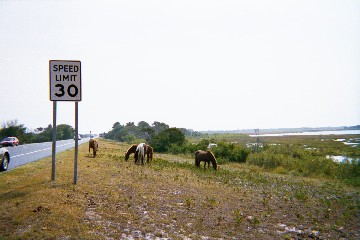
|
Visitors are guided through each of these unique environments on paths provided to prevent hikers from straying off and damaging the ecosystem. There is ample information about the different habitats and their inhabitants exhibited along the trails on colorful displays, and there are scenic overlooks with benches where visitors can pause a minute to take in the sights and sounds of the area. On our visit this year we were rewarded with glimpses of many types of birds, including a great blue heron and several snowy egrets, and we were amazed at the large number of small fishes that made the safety of the salt marsh their home.
|
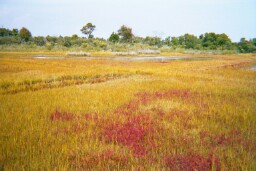
|
A view of the salt marsh from the "Life of the Marsh" nature trail. This "sea" of cordgrass provides food and shelter to a wide variety of creatures, among them nesting birds, fiddler crabs, salt marsh snails, and salt marsh mosquitoes. The cordgrass is one of the wild poniesí major food sources, and it was in the marsh that we were treated to the sight of the great blue heron.
|
Day visitors may drive along the paved roads of the National Park, picnic by the bay, enjoy the ocean sideís sandy beaches, fish, crab, and canoe. The park has never seemed crowded when we have been there; there is plenty of quiet space to enjoy the scenery. For those who wish to stay longer there is camping available. The campsites seem much more private and less crowded than in other campgrounds I have seen, and for those who are real wilderness buffs, there are campsites south of the paved area that can only be reached by canoe or backpacking.
|
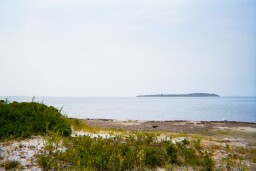
|
A view of Sinepuxent Bay from the picnic area. This bay is the feeding grounds and nursery for a wide variety of marine life. Some residents of the eel grass meadows are hermit crabs, sea nettles, the common tern, northern bluefish, horseshoe and blue crabs, and stout razor and hard shell clams.
|
|
This is the dune habitat as seen from the "Life of the Dunes" trail. Closer to the ocean only the toughest of beach grasses can withstand conditions, but as you move farther inland you are greeted by various low heathers and small shrubs that eventually give way to low loblolly pines. Birds are known to nest in the dune grasses, and many insects abound in this environment.
|
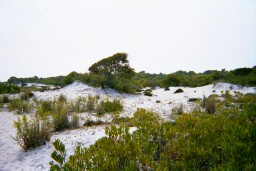
|
|
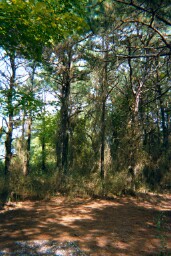
|
Two views of the forest area of Assateague. Note in the right hand picture the presence of phragmites, the tall reedy plants lining the path that signify a fringe area between the forest and marsh habitats. Thickets within the wooded areas provide resting areas for the wild ponies and small Sitka deer that are among the areas residents.
|

|
The thing that strikes me as most amazing about the Assateague Island National Park is that if it werenít for the intervention of "Mother Nature" herself the park would never have come to be. During the 1940ís and 1950ís Assateague was a developerís dream. People were looking for their little piece of seaside heaven, and the island was divided into 9000 building lots. A 15 mile long road, known as Baltimore Boulevard ran the length of the island to the Virginia state line, and smaller roads intersected this main route at regular intervals, turning what was once a pristine wilderness into a potential checkerboard of crowded humanity. According to one informational sign in the park, Assateague would probably resemble the noisy crowded tourist town of Ocean City, Maryland (which is also on a barrier island) if it were not for an extraordinary natural event. In 1962 a northeaster of staggering proportions hit the island, turning Baltimore Boulevard into scattered piles of asphalt and uprooting and decimating most of the homes that had already been built. Shaken by this experience, many of the property owners willingly sold their land to the government and in 1964 the National Seashore was created, allowing the land to undergo a secondary succession to its original state and preserving it in that way for all time.
|
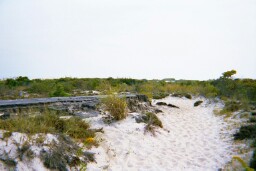
|
All that is left of Baltimore Boulevard, which was the only paved road to be constructed on the island before it became a National Seashore. It is at the same time a symbolic reminder of the power of natural forces and of the tragedy that would have been if this pristine island had been turned over to human population.
|
The National Parks Service operates a visitors' information center on the road leading to the park. There are educational displays, including an aquarium containing many of the local species of aquatic life and a touch pool where one can get acquainted with the unusual horseshoe crab. There is also a shop where you can buy informative books relating to the island and its points of interest, as well as other merchandise designed to remind you of your visit. On this trip I purchased Handbook 106 produced by the Division of Publications of the National Parks Service entitled Assateague Island: A Guide to Assateague Island National Seashore, which is a source for some of the information contained in this exploration. The proceeds from the sales of merchandise go towards the operation of the National Parks. There are Park Service employees on hand who are quite happy to answer any questions you may have about the island as well. Assateague Island is indeed a national treasure and a very special place to enjoy and learn more about how vital it is for us to protect and preserve out natural places. A visit there would be an enriching experience for nature-lovers young and old.
Submitted to and posted by Anthony Benoit
October 22, 2001
Top | Back | Explorations | ENV 1100






